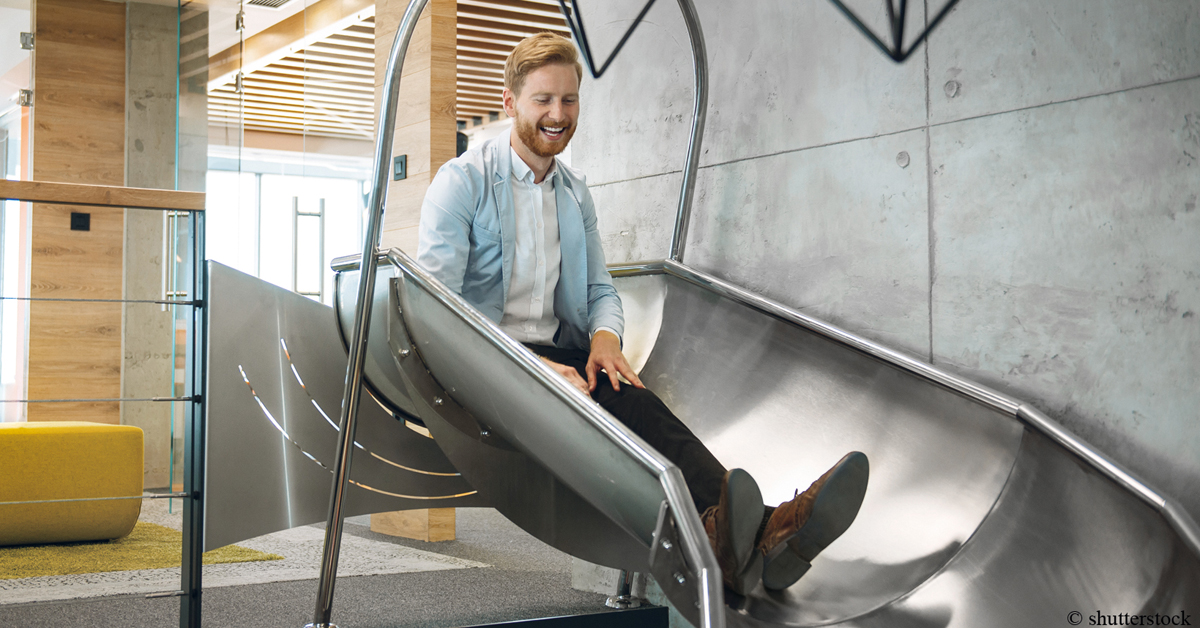Office culture: instruction manual for siestas and ball pools.
By Wojciech Czaja, 02.12.2019

Company culture sounds great. Let’s build spaces for our employees which are just good fun! But watch out: it’s not that simple. The spatial offer must always be in line and fine-tuned with the spirit of the company.
For most travellers to Thailand, the address Chaeng Wattana is associated with bad experiences. The long street in the north of Bangkok is a nervous ordeal, since this is where the Foreign Ministry with authorities for visa applications and working and residence permits can be found. Here, there is usually a waiting time of several hours.
For a few months, however, there has been the option to speed up the long wait in the truest sense of the word. On the second floor of the massive Ratthaprasasanabhakti Building, the covered atrium of which has an open space for trade fairs and events, a 412-metre-long running track with a total of three lanes has been set up. Corresponding pictograms on the ground give information about the speed you should choose: walking, jogging, running. You can track, measure and store your running distance via an app which you can install on your smartphone. On information screens along the track, you can see your name. “Sky running” is the official title of the indoor installation. It is one of the most unusual and media-effective projects of Bangkok property developer Dhanarak Asset Development. An important factor is that the track is not just open to the employees, but can also be used by customers and applicants. Guests who prefer to run some laps in the air-conditioned space instead of breathing in the exhaust fumes on the Bangkok streets are also welcome.
Space as a promise.
“A great project”, says Martin A. Ciesielski, who founded the “School of Nothing” in Berlin in 2017 and now presides over it as the Head of Nothing. He handles company consulting, social prototyping and training for digital leadership competences. “But these kinds of exotic offers in the office must always match the respective company culture. If this isn’t the case, if the running tracks, table football, hammocks, bunks and ball pits do not reflect the spirit of the company, sooner or later, this will lead to tension within the team.” In some ways, says Ciesielski, these gadgets and spatial features can be understood as a promise. “A ball pit promises a cool, casual company culture where it is legitimate to take time out at some point during the day and bury yourself in the plastic balls. If the company culture cannot fulfil this materially manifest, yet immaterial promise, however, then the plan backfires. Everything is no more than fake, and in the end, this will do more harm than good.”
Bernhard Kern, Managing Director of Roomware Consulting GmbH, also warns against too much amusement at the cost of authenticity: “There are definitely companies where it’s suitable to install a running track, gym, slide, gondola or kitchen covered in graffiti by street artists. But I absolutely warn against using these elements as a marketing instrument and fake employer branding. In any case, the spatial offer must be derived from the spirit of the company. First the culture, then the space.” This would also apply to the office layout with open-plan solutions and desk-sharing with the clean desk policy. A tangible discrepancy between space and culture must, according to Kern, result in conflicts sooner or later.
The siesta dictionary.
“Workplaces are essentially living spaces. There, the everyday life actually labelled as private is continued”, writes emeritus social psychologist and former director of the Berlin School of Economics and Law, Peter Heinrich, in his dictionary on micropolitics, published by Springer. “The hours that someone spends at their workplace each day are lived life, the quality of which also depends on the attention that the company and the creators use when designing the working environment. This refers to both the spatial-physical level and the social-communicative environments.” From this viewpoint, we must deal with the space available in the office in a reflective and, above all, cautious manner – whether these are think-tanks, animated centre areas or contemplative silent rooms for naps or for carrying out religious practices.
Architect Michael Anhammer, Partner at the Viennese office Franz&Sue, has experienced this first hand. Previously consisting of two separate offices called Franz and Sue, they merged within a very short time and have grown to a total of 50 employees. In their newly created residential and office building Stadtelefant in Sonnwendviertel, the giant city expansion area behind Vienna’s main train station, Franz&Sue created a two-storey architecture office with an inter-floor arena, meeting cubicles, standing desks, two balconies, a large terrace and even two reclining bunks arranged one above the other, which remind you of the classic ÖBB sleeper cabins. The new office has been up and running since the start of the year.
“We created the spatial offer and assumed that the corresponding culture would establish itself among our employees in an informal and uncomplicated manner”, says Anhammer. But then, we noticed: the things which work communally in a small team need certain rules of play in an office with 50 people, as well as a communication process initiated by the managing directors. “In the first few weeks, our employees didn’t know whether and how they could use these retreat spaces that we created. In the meantime, we have set up a format called High-Five which takes place every four to six weeks and where five partners meet five selected team delegates. Here, we work together on our office quality and organisation culture. This kind of oral history with room for negotiation is certainly preferable to hard, quantifiable rules of play.”
Precise formulation of goals.
These processes are vitally important for any change within the company, confirms Sabine Zinke: “A spatial model must always go hand in hand with the definition, or with the change of a cultural, technical or economical model”, says the Head of the business area “Changing Worlds of Work” at Viennese Consulting Company M.O.O.CON. “The more precisely the goals are formulated, the better! Nothing is more counter-productive than empty, hollow marketing words which haven’t been properly thought through.” Above all, this relates to trend concepts such as flexibility, agile working and transparent communication.
“I can strongly recommend thinking through consequences and interactions,” says Zinke. “If we suppose that middle management loses its individual offices and moves into the open plan office: what effects would this have on the everyday work? How would the communication processes change? And what contribution can we make so that the employees don’t perceive this change as control?” This all needs to be communicated, discussed and agreed – for example, in the form of regular neighbourhood councils.
Focus on the spirit.
Jens Kapitzky knows that you always have to look behind the scenes with these kinds of councils and strategy workshops. Jens Kapitzky ran the Österreichischer Bundesverlag from 2010 until 2015 and today runs Metaplan-Akademie in Schleswig-Holstein, which specialises in organisation consulting. “Space and company culture can come together in a wonderful harmony. But you also have to dig deeper,” says Kapitzky. And he explains in plain terms: “In every organisation, there are three levels – the display side, the formal side and the informal side. Skip the display side! There, you will mainly only find naive hollow words which the company uses to adorn itself officially and for marketing purposes. If you want to create sustainable change, then this has to happen on the formal and informal sides. And this only works if you deal with the employees, their preferences and idiosyncrasies on a very profound level, with the spirit of the company – meaning with everything that every person affected feels and knows, but that isn’t written down anywhere.”
According to a Gallup study carried out last year, 71 percent of Germans perform their tasks by the book. 14 percent even state that they have already mentally checked out of the company they work for. The numbers are alarming. There is an urgent need for action.




